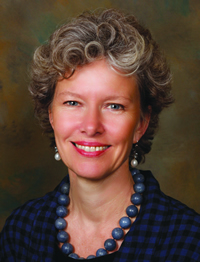New classification criteria for Sjögren’s syndrome are moving toward acceptance by both ACR and EULAR, the European League Against Rheumatism. The new criteria will replace both provisional ACR criteria from 2011 and the American-European Consensus Group criteria that have been a de facto standard for the past decade.

“The new ACR criteria were developed through the Sjögren’s International Collaborative Clinical Alliance, funded by the National Institutes of Health,” said Caroline H. Shiboski, DDS, MPH, PhD, Leland A. and Gladys K. Barber Distinguished Professor in Dentistry and Chair of Orofacial Sciences at the University of California, San Francisco. “We came together with the EULAR Sjögren’s syndrome task force and discovered a significant amount of concordance between the new ACR criteria and the AECG criteria. We were able to come up with consensus criteria that could be endorsed by both EULAR and ACR, a significant move forward for both groups.”
Dr. Shiboski will lead a symposium on the New ACR-EULAR Sjögren’s Syndrome Classification Criteria and Updates today from 4:30 – 6:00 pm. Other presenters will examine the utility of the new criteria in clinical practice and in clinical trials.

“These new criteria are going to have a strong positive impact because we will finally have uniform classification criteria for clinical trials and epidemiological studies on both sides of the Atlantic and all over the world,” said Raphaèle Seror, MD, PhD, clinical rheumatologist at Hopitaux Universitaires Paris-Sud in France. “These new criteria will also help to conduct clinical trials because they are more flexible and allow us to select patients in the earlier stages of Sjögren’s who are more likely to show improvement with treatment.”
Previous criteria for Sjögren’s essentially required the presence of dry mouth or dry eye symptoms for enrollment in clinical trials, Dr. Seror said. But mucosal dryness doesn’t always present in the earlier stages of the disease and in patients with systemic complications. The new criteria should help trialists enroll patients more likely to show benefit from treatment.
The new criteria also should help more rheumatologists take a more active role in the diagnosis of Sjögren’s. The prior provisional ACR criteria required rheumatologists to refer patients to either an ophthalmologist for an ocular staining score or to an oral medicine specialist for a salivary gland biopsy to confirm a diagnosis of Sjögren’s. The new criteria add the Schirmer test for dry eye and a 5-minute salivary flow test, both of which can be conducted in the rheumatology office.
Dr. Shiboski said referral to the other specialties is necessary for dry eye care, prevention of dry mouth-induced caries, and treatment of oral candidiasis, which is often a complication of dry mouth. The histopathological pattern seen in the labial salivary gland biopsy may provide useful prognostic information such as the presence of germinal centers and risk of lymphoma.
And the new criteria add weighting to the different diagnostic tests.
Two tests receive three points each, the focus score for focal lymphocytic sialoadenitis and the presence of Sjögren’s syndrome antibody A. Three tests receive one point each, a Schirmer test for dry eye showing 5 mm/5 min or less, an ocular staining score of five or greater, and a salivary flow rate of less than 0.1 mL per minute. A total of four points is required to confirm Sjögren’s.
“If a rheumatologist suspects Sjögren’s, the first step is serology to check for anti-SSA antibodies,” Dr. Shiboski said. “If it comes back positive, some rheumatologists may be able to do a Schirmer and salivary flow testing in the office to confirm the diagnosis. Standard of care requires an ophthalmologist and a dental medicine specialist to manage ocular and oral symptoms, but these criteria mean many cases can be correctly classified by the rheumatologist alone.”
